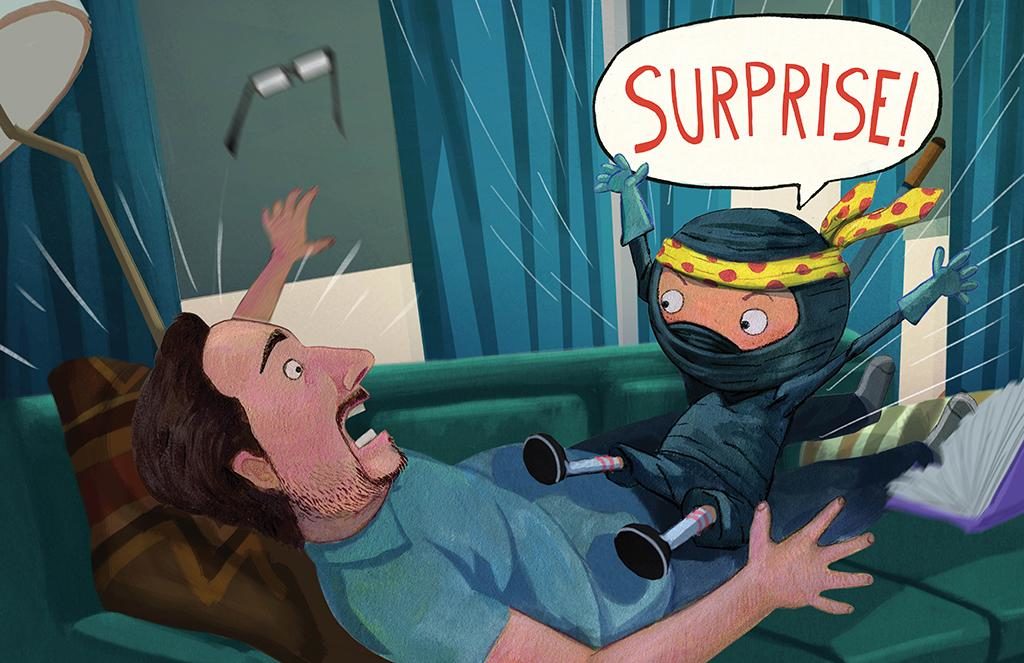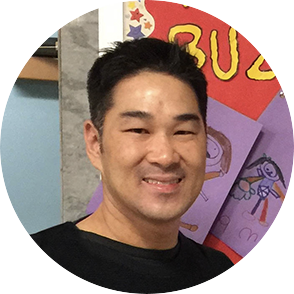Five Page Turns for Picture Book Writers and Illustrators

One of the most important epiphanies I’ve had about writing picture books came when I took Arree’s class in 2017 and learned about page turns. Picture books are a visual art form. Page turns are an important part of the storytelling, but I—like so many picture book writers—had never taken that into account when writing a story. Making a dummy and learning about page turns changed that for me.
There are so many things that you can do to make your stories more fun if you play with page turns. In the following video, Arree talks about the different kinds of pages turns that you can use.
Movement Page Turns
This page turn is all about getting the biggest impact out of the smallest change. You’re using the same illustration from one page to the next, only changing one thing. The example Arree gives in the video is from Jon Klassen’s This Is Not My Hat.
“I stole it from a big fish. He was asleep when I did it.” [Illustration: The big fish is asleep.]
The page turns.
“And he probably won’t wake up for a long time.” [Illustration: The big fish opens his eyes (wakes up).]
Changing just that one thing is powerful, especially the way that Jon Klassen uses it to contradict what the narrator is saying.
Some industry professionals say not to use illustration notes—because so many writers want to use them to describe things that an illustrator doesn’t need to have described—but this is what they’re really for.
Before and After Page Turns
This page turn is similar to a movement page turn. You use it to show transformation. Arree used Fancy Nancy, by Jane O’Conner and Robin Preiss Glasser, to illustrate this page turn. There’s a huge difference between Nancy’s room before and after it becomes fancy. They use this page turn to establish character visually before the story even starts, which is so smart for a character-based picture book.
Rhythm and Repetition Page Turns
Brendan Wenzel’s They All Saw a Cat utilizes this page turn so well that I’m going to share an old book trailer for it that shows why the rhythm and repetition page turn is one that you can incorporate into your story.
If your picture book relies on rhythm, rhyming, repetition, and/or a refrain, I highly recommend that you study They All Saw a Cat as a mentor text.
It also showcases some . . .
Continuing Sentence Page Turns
This page turn uses an ellipsis (. . .) to lead you from one page to another. Be careful about using ellipses. They should be a bridge from one thing to another. Too many beginning writers want to leave the reader hanging on the other side, and that doesn’t work for the punctuation or for this particular page turn. It actually works best if you use it to lead up to something cool.
Arree uses an example from his picture book, Ninja!
“He will face danger, show courage, and find the strength to defeat angry beasts. A ninja must master the element of . . .”
The page turns.
“SURPRISE!” (The illustration for this is at the top of this post.)
Tension Page Turns
With this one, you use multiple page turns to build tension and lead up to some kind of reveal. As a writer, this is where you’re escalating the emotion in your story to lead up to the climax. The reveal doesn’t have to be the climax, but it should certainly be leading you there.
In Jan Brett’s The Mitten, each animal that squeezes into the mitten adds to the tension. As a reader, you know that it’s going to be too much for the mitten at some point. My preschoolers used to giggle when the bear sneezed, and I think it was brilliant of Jan Brett to use humor there to release the tension.
Gianna Marino uses the same kind of tension page turns in Night Animals. She starts out with Possum, who is hiding. Possum is quickly joined by Skunk, and they are joined by other night animals who are progressively larger, scarier, and more terrified of night animals than they are. The reveal for this one—as you can probably tell by the set up—also comes through humor.
The example that Arree shares from Ninja! Attack of the Clan escalates excitement and releases tension through disappointment, ultimately leading to an exciting, satisfying ending.
Utilizing Page Turns
There are a lot of different ways that you can use all of these page turns. Don’t feel like you have to follow some kind of formula. Instead, see if you can identify page turns in the picture books that you’re reading, especially in mentor texts you may be studying for your own stories, to see how they enhance the storytelling.
Finally, look at your own stories. Would incorporating any of these page turns take the story you’re revising to another level of awesome? I hope you experiment and find out!
Thanks for reading! If you have any questions, please drop them in the comments, and I’ll do my best to answer them.
And please share examples of page turns as you discover them in your studies!
Blog Contributors

Myrna Foster writes and edits content for Storyteller Academy and the WriteRiders Newsletter for SCBWI Nevada. She has spent a lot of time teaching and coaching children, including five years as a preschool teacher. She's also worked as a journalist, and Highlights High Five has published six of her poems.

Arree Chung is an author/illustrator and the founder of Storyteller Academy. Arree’s Ninja! series has received starred reviews from Kirkus and School Library Journal. Kirkus also gave a starred review to Mixed, which recently won the FCGB award.
Today Arree lives a creative life, making stories for children. Arree spends most of his time making picture books, writing middle grade novels, and sharing his love for art, design, and storytelling with kids and dreamers everywhere.
